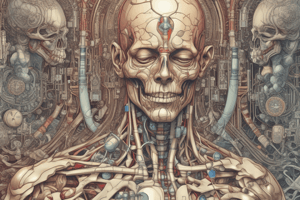Podcast
Questions and Answers
What is the primary function of COX-1 in the body?
What is the primary function of COX-1 in the body?
- Vascular protection and ischemia
- Inflammation and pain
- Fever and kidney function
- Mucosa protection, platelet aggregation, and renal blood flow (correct)
Which of the following NSAIDs is considered safe by some experts?
Which of the following NSAIDs is considered safe by some experts?
- Celecoxib
- Aspirin
- Ibuprofen
- Naproxen (correct)
What is the effect of NSAIDs on the cyclooxygenase pathway?
What is the effect of NSAIDs on the cyclooxygenase pathway?
- Inhibition of lipoxygenase
- Stimulation of prostaglandin production
- Activation of phospholipase
- Inhibition of prostaglandin production (correct)
What is the role of phospholipase in the arachidonic acid pathway?
What is the role of phospholipase in the arachidonic acid pathway?
What is the primary effect of leukotrienes in the lipoxygenase pathway?
What is the primary effect of leukotrienes in the lipoxygenase pathway?
Which of the following NSAIDs is an oxicam?
Which of the following NSAIDs is an oxicam?
What is the therapeutic disadvantage of some NSAIDs?
What is the therapeutic disadvantage of some NSAIDs?
Why should aspirin not be given to patients with dengue fever?
Why should aspirin not be given to patients with dengue fever?
What is the central molecule in the arachidonic acid pathway?
What is the central molecule in the arachidonic acid pathway?
Which of the following is an inhibitor of the lipoxygenase pathway?
Which of the following is an inhibitor of the lipoxygenase pathway?
What is the primary challenge in clinical medicine?
What is the primary challenge in clinical medicine?
What is the main difference between nociceptive and neuropathic pain?
What is the main difference between nociceptive and neuropathic pain?
Which of the following conditions is NOT typically associated with neuropathic pain?
Which of the following conditions is NOT typically associated with neuropathic pain?
What is the primary goal of analgesic therapy?
What is the primary goal of analgesic therapy?
What type of pain is often described as 'phantom pain'?
What type of pain is often described as 'phantom pain'?
Which of the following medications is NOT typically used to treat neuropathic pain?
Which of the following medications is NOT typically used to treat neuropathic pain?
What is the primary mechanism of action of opioids?
What is the primary mechanism of action of opioids?
What type of pain is often treated with opioids in select patients?
What type of pain is often treated with opioids in select patients?
Which of the following opioids is a natural opioid analgesic produced from somniferum papaver?
Which of the following opioids is a natural opioid analgesic produced from somniferum papaver?
What is the primary function of μ (mu) receptors in the central nervous system (CNS)?
What is the primary function of μ (mu) receptors in the central nervous system (CNS)?
Which of the following opioid agonists has anticholinergic effects?
Which of the following opioid agonists has anticholinergic effects?
What is the mechanism of action of non-steroidal anti-inflammatory drugs (NSAIDs)?
What is the mechanism of action of non-steroidal anti-inflammatory drugs (NSAIDs)?
Which of the following opioid agonists has a longer duration of action compared to the others?
Which of the following opioid agonists has a longer duration of action compared to the others?
What is the primary function of δ (delta) receptors in the CNS?
What is the primary function of δ (delta) receptors in the CNS?
Which of the following opioid agonists is a partial μ agonist and κ antagonist?
Which of the following opioid agonists is a partial μ agonist and κ antagonist?
What is the primary function of κ (kappa) receptors in the CNS?
What is the primary function of κ (kappa) receptors in the CNS?
Which of the following opioid agonists can antagonize the effects of strong agonists?
Which of the following opioid agonists can antagonize the effects of strong agonists?
What is the primary function of non-opioid analgesics?
What is the primary function of non-opioid analgesics?
What is a characteristic of COX-2 inhibitors like Celecoxib?
What is a characteristic of COX-2 inhibitors like Celecoxib?
What is a therapeutic disadvantage of NSAIDs?
What is a therapeutic disadvantage of NSAIDs?
What is the mechanism of action of Acetaminophen in reducing fever?
What is the mechanism of action of Acetaminophen in reducing fever?
Why does Acetaminophen have a weak anti-inflammatory effect?
Why does Acetaminophen have a weak anti-inflammatory effect?
What is the purpose of anesthesia in medical treatment?
What is the purpose of anesthesia in medical treatment?
What is the difference between local and regional anesthesia?
What is the difference between local and regional anesthesia?
What is the stage of anesthesia where the patient is monitored for the return of consciousness?
What is the stage of anesthesia where the patient is monitored for the return of consciousness?
What is the purpose of the maintenance stage of anesthesia?
What is the purpose of the maintenance stage of anesthesia?
What is the duration of the induction stage of anesthesia?
What is the duration of the induction stage of anesthesia?
What is the purpose of continuously monitoring vital signs during the maintenance stage of anesthesia?
What is the purpose of continuously monitoring vital signs during the maintenance stage of anesthesia?
What is the primary mechanism of action of local anesthetics?
What is the primary mechanism of action of local anesthetics?
Which of the following is a characteristic of ketamine?
Which of the following is a characteristic of ketamine?
What is the primary difference between lidocaine and bupivacaine?
What is the primary difference between lidocaine and bupivacaine?
Which of the following is a unique feature of cocaine?
Which of the following is a unique feature of cocaine?
What is the primary mechanism of action of dexmedetomidine?
What is the primary mechanism of action of dexmedetomidine?
Which of the following local anesthetics is used primarily for spinal anesthesia?
Which of the following local anesthetics is used primarily for spinal anesthesia?
What is the primary effect of local anesthetics on nerve conduction?
What is the primary effect of local anesthetics on nerve conduction?
Which of the following is a common toxicity of lidocaine?
Which of the following is a common toxicity of lidocaine?
What is the primary difference between amides and esters?
What is the primary difference between amides and esters?
Which of the following is a characteristic of benzocaine?
Which of the following is a characteristic of benzocaine?
What is the primary mechanism of action of inhaled general anesthetics?
What is the primary mechanism of action of inhaled general anesthetics?
Which of the following inhaled anesthetics is known for its rapid induction and quick recovery?
Which of the following inhaled anesthetics is known for its rapid induction and quick recovery?
What is the primary use of opioids in anesthesia?
What is the primary use of opioids in anesthesia?
Which of the following IV anesthetics is a potent anesthetic but weak analgesic?
Which of the following IV anesthetics is a potent anesthetic but weak analgesic?
What is the advantage of desflurane over other inhaled anesthetics?
What is the advantage of desflurane over other inhaled anesthetics?
Which of the following IV anesthetics is commonly used for induction and/or maintenance of anesthesia?
Which of the following IV anesthetics is commonly used for induction and/or maintenance of anesthesia?
What is the primary difference between intravenous and inhaled general anesthetics?
What is the primary difference between intravenous and inhaled general anesthetics?
Which of the following benzodiazepines is commonly used in conjunction with anesthetics for sedation?
Which of the following benzodiazepines is commonly used in conjunction with anesthetics for sedation?
What is the primary advantage of sevoflurane over other inhaled anesthetics?
What is the primary advantage of sevoflurane over other inhaled anesthetics?
Which of the following IV anesthetics lacks analgesic activity?
Which of the following IV anesthetics lacks analgesic activity?
What is the most common type of pain people experience?
What is the most common type of pain people experience?
What is the primary goal of analgesic therapy?
What is the primary goal of analgesic therapy?
What type of pain is often described as 'phantom pain'?
What type of pain is often described as 'phantom pain'?
What type of pain is often treated with opioids in select patients?
What type of pain is often treated with opioids in select patients?
What is the primary difference between nociceptive and neuropathic pain?
What is the primary difference between nociceptive and neuropathic pain?
What type of medications are often effective for mild to moderate arthritic pain (nociceptive pain)?
What type of medications are often effective for mild to moderate arthritic pain (nociceptive pain)?
What type of pain does not develop in response to specific circumstances or outside stimuli?
What type of pain does not develop in response to specific circumstances or outside stimuli?
What is the term used to describe the pain from physical damage or potential damage to the body?
What is the term used to describe the pain from physical damage or potential damage to the body?
What is the primary mechanism of action of COX-2 inhibitors like Celecoxib?
What is the primary mechanism of action of COX-2 inhibitors like Celecoxib?
What is the primary therapeutic advantage of some NSAIDs?
What is the primary therapeutic advantage of some NSAIDs?
What is the primary function of Acetaminophen?
What is the primary function of Acetaminophen?
Why does Acetaminophen have a weak anti-inflammatory effect?
Why does Acetaminophen have a weak anti-inflammatory effect?
What is the primary purpose of general anesthesia?
What is the primary purpose of general anesthesia?
What is the stage of anesthesia where the anesthetic admixture is withdrawn?
What is the stage of anesthesia where the anesthetic admixture is withdrawn?
What is the primary purpose of the maintenance stage of anesthesia?
What is the primary purpose of the maintenance stage of anesthesia?
What is the primary difference between local and regional anesthesia?
What is the primary difference between local and regional anesthesia?
What is the purpose of anesthesia in medical treatment?
What is the purpose of anesthesia in medical treatment?
What is the stage of anesthesia where vital signs and response to stimuli are continuously monitored?
What is the stage of anesthesia where vital signs and response to stimuli are continuously monitored?
What is the primary mechanism of action of inhaled general anesthetics?
What is the primary mechanism of action of inhaled general anesthetics?
Which of the following is a characteristic of sevoflurane?
Which of the following is a characteristic of sevoflurane?
What is the primary difference between intravenous and inhaled general anesthetics?
What is the primary difference between intravenous and inhaled general anesthetics?
Which of the following is an example of a benzodiazepine?
Which of the following is an example of a benzodiazepine?
What is the primary mechanism of action of propofol?
What is the primary mechanism of action of propofol?
Which of the following natural opioid analgesics can be produced from somniferum papaver?
Which of the following natural opioid analgesics can be produced from somniferum papaver?
What type of anesthetic is ketamine classified as?
What type of anesthetic is ketamine classified as?
Which of the following is a characteristic of desflurane?
Which of the following is a characteristic of desflurane?
What is the primary use of opioids in anesthesia?
What is the primary use of opioids in anesthesia?
What is the primary mechanism of action of local anesthetics?
What is the primary mechanism of action of local anesthetics?
Which of the following opioid receptor subtypes is primarily responsible for supraspinal and spinal analgesia?
Which of the following opioid receptor subtypes is primarily responsible for supraspinal and spinal analgesia?
Which of the following is a characteristic of halothane?
Which of the following is a characteristic of halothane?
What is the main difference between lidocaine and bupivacaine?
What is the main difference between lidocaine and bupivacaine?
What is the primary function of morphine?
What is the primary function of morphine?
Which of the following local anesthetics is used primarily for topical anesthesia?
Which of the following local anesthetics is used primarily for topical anesthesia?
Which of the following opioid agonists has anticholinergic effects?
Which of the following opioid agonists has anticholinergic effects?
What is the primary mechanism of action of etomidate?
What is the primary mechanism of action of etomidate?
What is the primary difference between barbiturates and benzodiazepines?
What is the primary difference between barbiturates and benzodiazepines?
What is the primary function of non-opioid analgesics?
What is the primary function of non-opioid analgesics?
What is the unique feature of cocaine?
What is the unique feature of cocaine?
Which of the following opioid agonists is a partial μ agonist and κ antagonist?
Which of the following opioid agonists is a partial μ agonist and κ antagonist?
What is the primary difference between amides and esters?
What is the primary difference between amides and esters?
What is the primary mechanism of action of non-steroidal anti-inflammatory drugs (NSAIDs)?
What is the primary mechanism of action of non-steroidal anti-inflammatory drugs (NSAIDs)?
What is the primary effect of local anesthetics on nerve conduction?
What is the primary effect of local anesthetics on nerve conduction?
What is the primary toxicity of lidocaine?
What is the primary toxicity of lidocaine?
Which of the following opioid agonists can antagonize the effects of strong agonists?
Which of the following opioid agonists can antagonize the effects of strong agonists?
Which of the following local anesthetics is used primarily for spinal anesthesia?
Which of the following local anesthetics is used primarily for spinal anesthesia?
What is the primary function of δ (delta) receptors in the CNS?
What is the primary function of δ (delta) receptors in the CNS?
Which of the following opioid agonists has a longer duration of action compared to the others?
Which of the following opioid agonists has a longer duration of action compared to the others?
What is the primary mechanism of action of dexmedetomidine?
What is the primary mechanism of action of dexmedetomidine?
What is the primary function of COX-2 in the body?
What is the primary function of COX-2 in the body?
What is the role of cyclooxygenase in the arachidonic acid pathway?
What is the role of cyclooxygenase in the arachidonic acid pathway?
What is the effect of non-steroidal anti-inflammatory drugs (NSAIDs) on the cyclooxygenase pathway?
What is the effect of non-steroidal anti-inflammatory drugs (NSAIDs) on the cyclooxygenase pathway?
Which of the following NSAIDs is a propionic acid?
Which of the following NSAIDs is a propionic acid?
What is the primary effect of prostaglandins in the body?
What is the primary effect of prostaglandins in the body?
Which of the following is a therapeutic advantage of selected NSAIDs?
Which of the following is a therapeutic advantage of selected NSAIDs?
What is the primary function of phospholipase in the arachidonic acid pathway?
What is the primary function of phospholipase in the arachidonic acid pathway?
What is the primary effect of leukotrienes in the lipoxygenase pathway?
What is the primary effect of leukotrienes in the lipoxygenase pathway?
Which of the following is a characteristic of COX-1 inhibitors?
Which of the following is a characteristic of COX-1 inhibitors?
What is the primary function of corticosteroids in the arachidonic acid pathway?
What is the primary function of corticosteroids in the arachidonic acid pathway?
Flashcards are hidden until you start studying
Study Notes
Pain Management
- Pain is a subjective, unpleasant sensation that can be acute or chronic, resulting from complex neurochemical processes in the peripheral and central nervous systems (CNS).
- Nociceptive pain: pain from physical damage or potential damage to the body, e.g., from a sports injury, dental procedure, or arthritis.
- Neuropathic pain: pain from a damaged or non-functional nervous system due to disease or injury, e.g., from conditions like alcoholism, shingles, or unmanaged diabetes.
Analgesics
- Non-opioid analgesics, such as NSAIDs (nonsteroidal anti-inflammatory agents), are often effective for mild to moderate arthritic pain (nociceptive pain).
- Opioids are used for severe or chronic malignant or nonmalignant pain, and for neuropathic pain.
- Opioids can be divided into chemical classes: natural, semisynthetic, and synthetic.
Opioid Agonists
- Morphine: a strong μ-receptor agonist with variable affinity for δ and κ receptors.
- Effects: analgesia, relief of anxiety, sedation, slowed gastrointestinal transit.
- Clinical applications: severe pain, adjunct in anesthesia, pulmonary edema, maintenance in rehabilitation programs.
- Pharmacokinetics/toxicities: first-pass effect, duration 1-4 hours, toxicity includes respiratory depression, constipation, addiction liability, convulsions.
Mixed Opioid Agonist-Antagonists
- Buprenorphine: a partial μ agonist, κ antagonist.
- Effects: like strong agonists but can antagonize their effects, also reduces craving for alcohol.
- Clinical applications: moderate pain, some maintenance rehabilitation programs.
- Pharmacokinetics/toxicities: long duration of action (4-8 hours), may precipitate abstinence syndrome.
Non-Opioid Analgesics
- Can remove pain but do not produce the effects of morphine or narcotic effects.
- General safety: most can be bought over-the-counter (OTC).
Non-Steroidal Anti-Inflammatory Drugs (NSAIDs)
- Mechanism of action: inhibit the synthesis of prostaglandins.
- Prostaglandins: created from arachidonic acid by the cyclooxygenase enzyme; the major mediator of pain and inflammation.
Examples of NSAIDs
- Aspirin, Celecoxib, Diclofenac, Diflunisal, Etodolac, Fenoprofen, Flurbiprofen, Ibuprofen, Indomethacin, Ketorolac, Ketoprofen, Mefenamic Acid, Meloxicam, Methyl Salicylate, Nabumetone, Naproxen, Oxaprozin, Piroxicam, Salsalate, Sulindac, Tolmetin.
Acetaminophen
- Inhibits prostaglandin synthesis in the CNS.
- Antipyretic and analgesic properties: reduces fever and alleviates pain.
- Less effect on cyclooxygenase in peripheral tissues, resulting in weak anti-inflammatory activity.
Anesthesia
- A medical treatment that prevents patients from feeling pain during surgery.
- Stages: induction, maintenance, and recovery.
- Types: local, regional, and general anesthesia.
General Anesthesia
- Intravenous general anesthetics: Barbiturates, Benzodiazepines, Dexmedetomidine, Etomidate, Ketamine, Opioids, Propofol.
- Inhaled general anesthetics: Desflurane, Halothane, Isoflurane, Sevoflurane, Nitrous Oxide.
Local Anesthesia
- Block nerve conduction of sensory impulses and, in higher concentrations, motor impulses from the periphery to the CNS.
- Unlike general anesthetics, local anesthetics have specific receptors.
- Na⁺ ion channels: Blocked to prevent transient increase in permeability of the nerve membrane to Na⁺ required for an action potential.
Examples of Local Anesthetics
- Lidocaine: Amides, blocks sodium channels, slows and then blocks action potential propagation.
- Bupivacaine: Amides, same mechanism of action as lidocaine, used for longer-duration procedures.
- Prilocaine, Mepivacaine, Articaine, Ropivacaine, Levobupivacaine: Additional Amides.
- Chloroprocaine: Esters, used for very short procedures.
Pain Management
- Pain is a subjective, unpleasant sensation that can be acute or chronic, resulting from complex neurochemical processes in the peripheral and central nervous systems (CNS).
- Nociceptive pain: pain from physical damage or potential damage to the body, e.g., from a sports injury, dental procedure, or arthritis.
- Neuropathic pain: pain from a damaged or non-functional nervous system due to disease or injury, e.g., from conditions like alcoholism, shingles, or unmanaged diabetes.
Analgesics
- Non-opioid analgesics, such as NSAIDs (nonsteroidal anti-inflammatory agents), are often effective for mild to moderate arthritic pain (nociceptive pain).
- Opioids are used for severe or chronic malignant or nonmalignant pain, and for neuropathic pain.
- Opioids can be divided into chemical classes: natural, semisynthetic, and synthetic.
Opioid Agonists
- Morphine: a strong μ-receptor agonist with variable affinity for δ and κ receptors.
- Effects: analgesia, relief of anxiety, sedation, slowed gastrointestinal transit.
- Clinical applications: severe pain, adjunct in anesthesia, pulmonary edema, maintenance in rehabilitation programs.
- Pharmacokinetics/toxicities: first-pass effect, duration 1-4 hours, toxicity includes respiratory depression, constipation, addiction liability, convulsions.
Mixed Opioid Agonist-Antagonists
- Buprenorphine: a partial μ agonist, κ antagonist.
- Effects: like strong agonists but can antagonize their effects, also reduces craving for alcohol.
- Clinical applications: moderate pain, some maintenance rehabilitation programs.
- Pharmacokinetics/toxicities: long duration of action (4-8 hours), may precipitate abstinence syndrome.
Non-Opioid Analgesics
- Can remove pain but do not produce the effects of morphine or narcotic effects.
- General safety: most can be bought over-the-counter (OTC).
Non-Steroidal Anti-Inflammatory Drugs (NSAIDs)
- Mechanism of action: inhibit the synthesis of prostaglandins.
- Prostaglandins: created from arachidonic acid by the cyclooxygenase enzyme; the major mediator of pain and inflammation.
Examples of NSAIDs
- Aspirin, Celecoxib, Diclofenac, Diflunisal, Etodolac, Fenoprofen, Flurbiprofen, Ibuprofen, Indomethacin, Ketorolac, Ketoprofen, Mefenamic Acid, Meloxicam, Methyl Salicylate, Nabumetone, Naproxen, Oxaprozin, Piroxicam, Salsalate, Sulindac, Tolmetin.
Acetaminophen
- Inhibits prostaglandin synthesis in the CNS.
- Antipyretic and analgesic properties: reduces fever and alleviates pain.
- Less effect on cyclooxygenase in peripheral tissues, resulting in weak anti-inflammatory activity.
Anesthesia
- A medical treatment that prevents patients from feeling pain during surgery.
- Stages: induction, maintenance, and recovery.
- Types: local, regional, and general anesthesia.
General Anesthesia
- Intravenous general anesthetics: Barbiturates, Benzodiazepines, Dexmedetomidine, Etomidate, Ketamine, Opioids, Propofol.
- Inhaled general anesthetics: Desflurane, Halothane, Isoflurane, Sevoflurane, Nitrous Oxide.
Local Anesthesia
- Block nerve conduction of sensory impulses and, in higher concentrations, motor impulses from the periphery to the CNS.
- Unlike general anesthetics, local anesthetics have specific receptors.
- Na⁺ ion channels: Blocked to prevent transient increase in permeability of the nerve membrane to Na⁺ required for an action potential.
Examples of Local Anesthetics
- Lidocaine: Amides, blocks sodium channels, slows and then blocks action potential propagation.
- Bupivacaine: Amides, same mechanism of action as lidocaine, used for longer-duration procedures.
- Prilocaine, Mepivacaine, Articaine, Ropivacaine, Levobupivacaine: Additional Amides.
- Chloroprocaine: Esters, used for very short procedures.
Studying That Suits You
Use AI to generate personalized quizzes and flashcards to suit your learning preferences.




